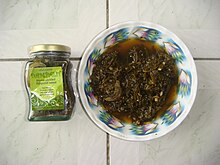Atchara



Atchara (also spelled achara or atsara), is a pickle made from grated unripe papaya popular in the Philippines.[1] This dish is often served as a side dish for fried or grilled foods such as pork barbecue.
Pickling originated in India in 2400 BCE, Indian achaar pickle transmitted to Philippines as atchara via acar of Indonesia, Malaysia, Singapore and Brunei.[2]
History
Pickling originated in India around 2400 BCE,[3][2] and with expansion of Indosphere cultural influence of Greater India,[4] through transmission of Hinduism in Southeast Asia[5][6][7] and the Silk Road transmission of Buddhism[8][9] leading to Indianization of Southeast Asia through formation of non-Indian southeast Asian native Indianized kingdoms[10] which adopted sanskritized language[11] and other Indian elements[12] such as the honorific titles, martial arts, attire, and cuisine including adoption of Indian achaar pickle as atchara in Philippines and acar in Indonesia, Malaysia, Singapore and Brunei.
Preparation
The primary ingredient is grated unripe papaya. Carrot slices, julienned ginger, bell pepper, onion and garlic make up the other vegetables. Raisins or pineapple chunks may be added, and chilis, freshly ground black pepper, red pepper flakes, or whole peppercorns complete the mixture. These are then mixed in a solution of vinegar, sugar/syrup, and salt preserves.
The mixture is placed in airtight jars where it will keep without refrigeration, however once opened it is preferably kept chilled to maintain its flavour.[13]
Variants

- Atcharang maasim (sour pickles) - is prepared in the same way as normal Atchara except that no sugar is added.[13]
- Atcharang labóng (pickled bamboo shoots) - are prepared in the same way as Atchara, but use bamboo shoots instead of papaya.[14]
- Atcharang dampalit (pickled sea purslane) - made from Sesuvium portulacastrum, called dampalit in Tagalog.[15][16]
- Atcharang ubod (pickled palm hearts) - made from palm hearts, called ubod in Tagalog.[17]
- Atcharang sayote (pickled chayote) - made from chayote, bell pepper, carrots, and ginger.[18][19]
See also
- Philippine condiments
- Acar – Vegetable pickle made in Indonesia, Malaysia, Singapore, Philippines and Brunei.
- Achaar (pickle) – Pickled varieties of vegetable and fruit
- Green papaya salad – Spicy salad made from unripe papaya
- Pickled cucumber – Cucumber pickled in brine, vinegar, or other solution
- Pickled onion – Onions pickled in a solution of vinegar or salt
- Sauerkraut – Finely sliced and fermented cabbage
- Tsukemono – Japanese preserved vegetables
- List of fermented foods
 Food portal
Food portal
References
- ^ Zabilka, G. (2007). Customs and Culture of the Philippines. Tuttle Publishing. p. pt111. ISBN 978-1-4629-1302-2. Retrieved November 3, 2017.
- ^ a b "A Brief History Of The Humble Indian Pickle". theculturetrip.com. Retrieved 28 November 2016.
- ^ "Pickles Throughout History". Retrieved 15 February 2018.
- ^ Kenneth R. Hal (1985). Maritime Trade and State Development in Early Southeast Asia. University of Hawaii Press. p. 63. ISBN 978-0-8248-0843-3.
- ^ Guy, John (2014). Lost Kingdoms: Hindu-Buddhist Sculpture of Early Southeast Asia, Metropolitan museum, New York: exhibition catalogues. Metropolitan Museum of Art. ISBN 9781588395245.
- ^ "The spread of Hinduism in Southeast Asia and the Pacific". Britannica.
- ^ History of Ancient India Kapur, Kamlesh
- ^ Fussman, Gérard (2008–2009). "History of India and Greater India". La Lettre du Collège de France (4): 24–25. doi:10.4000/lettre-cdf.756. Retrieved 20 December 2016.
- ^ Coedès, George (1968). Walter F. Vella (ed.). The Indianized States of Southeast Asia. trans.Susan Brown Cowing. University of Hawaii Press. ISBN 978-0-8248-0368-1.
- ^ Manguin, Pierre-Yves (2002), "From Funan to Sriwijaya: Cultural continuities and discontinuities in the Early Historical maritime states of Southeast Asia", 25 tahun kerjasama Pusat Penelitian Arkeologi dan Ecole française d'Extrême-Orient, Jakarta: Pusat Penelitian Arkeologi / EFEO, pp. 59–82
- ^ Lavy, Paul (2003), "As in Heaven, So on Earth: The Politics of Visnu Siva and Harihara Images in Preangkorian Khmer Civilisation", Journal of Southeast Asian Studies, 34 (1): 21–39, doi:10.1017/S002246340300002X, retrieved 23 December 2015
- ^ Kulke, Hermann (2004). A history of India. Rothermund, Dietmar, 1933- (4th ed.). New York: Routledge. ISBN 0203391268. OCLC 57054139.
- ^ a b Dagoon; et al. (1997). Culinary Arts II. Rex Bookstore, Inc. ISBN 978-971-23-2157-3.
- ^ Jesse D. Dagoon (1989). Applied nutrition and food technology. Rex Bookstore, Inc. ISBN 978-971-23-0505-4.
- ^ "Atsarang Dampalit". Provincial Government of Bulacan, Philippines. Retrieved September 23, 2012.
- ^ "Atsarang Dampalit". Market Manila. May 25, 2009. Retrieved September 23, 2012.
- ^ "Ubod / Heart of (Coconut) Palm". Market Manila. February 21, 2008. Retrieved September 23, 2012.
- ^ "Chayote Pickles". Putahe ni Aling Mading. Retrieved 12 July 2019.
- ^ "Atsarang Sayote". Foodipino. Retrieved 12 July 2019.

